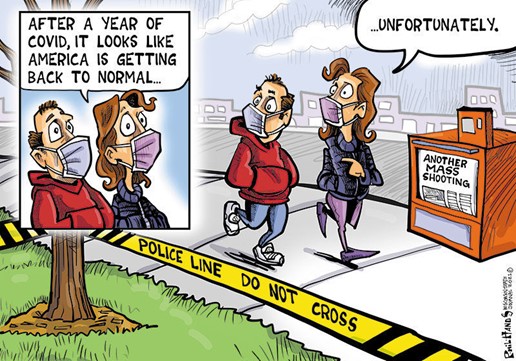We are recovering rapidly from the COVID disruptions. The economy is growing at a rate of 5-7% compared to the typical 2-3%. COVID cases and deaths are down 50-70% as we emerge from quarantine and begin to experience some ordinary social behavior. Things are certainly looking up, but during this COVID Recovery period, it’s critical that we continue taking advantage of opportunities to restore normalcy so that we can encourage personal prosperity and growth.
We are achieving major gains in areas like vaccinations, growing the economy, getting students back to school, and relaxing some guidelines. We’re also seeing an emphasis on social awareness as people continue working to end racial discrimination and minimize destruction in the Middle East. We’re feeling energized to make positive changes despite the fact that progress in areas like racism, gun control, infrastructure, and bipartisan efforts have been disappointing.

The most significant impact of the Pandemic is, perhaps, the acceleration of income inequality (which was already concerning prior to 2020). While most income tax rates have remained pretty consistent for decades, taxes for the top 1% have decreased from over 70% to under 30%. Thus, the country’s top earners have increased their wealth share from 60% to 80%. Inequality also extends to other areas like the K economy where the rich get richer and the poor get poorer. Companies like Alphabet, Amazon, Apple, Facebook, and other tech conglomerates are becoming more and more powerful in both social and economic programs.
There is a great deal of uncertainty regarding the work from home trend, but it will continue at a level of 20-30%, at least. The benefits (no commute time, reduced cost of office space) and improved technologies (Zoom) are too great to be ignored. However, we have not even seen the communication and interaction benefits that can be accomplished as more normal behavior resumes. Therefore, we need to manage, adapt, and develop effective solutions rather than try to execute personal or traditional preferences.

Furthermore, we need more innovation as part of the COVID Recovery. I believe efforts like Artificial Intelligence, electric cars, improved technology in education and business, better health care, solutions to prevent climate change, etc. can contribute to the acceleration of our economy. For example, Biden visited a Ford plant recently to introduce a new truck. It generated more excitement, interest, and publicity than many other efforts. Consider how gains in areas like this are a win-win with few losers or dissent.
Another trend we’re seeing is increased stress levels as a result of more shootings, crime, discrimination, and suicides. Even the Supreme Court is experiencing more stress related contentiousness. To make matters worse, for the last year, physical acts that once provided comfort and encouragement (hugs, high-fives, handshakes) were discouraged. As social creatures that crave human connection, it takes a toll on us mentally when we’re unable to find solace in a hug or vent at the water cooler with friends. On the plus side, however, we’re seeing these gestures being reincorporated into our routines as part of the COVID Recovery.
A positive trend that started during the pandemic (and seems to be sticking around) is an increased focus on mental health. Many people started talking with a therapist as quarantine took its toll. And many health insurance companies encouraged this by offering free counseling services. Hopefully, we continue to proactively manage stress and take time to practice mindfulness because pretending problems don’t exist, overextending ourselves, and being too stubborn to ask for help are all surefire ways to make stress worse. You may be able to keep it bottled up for some time, but it will eventually find a way to rear its head.
x
The pandemic affected women in a variety of ways. Poor women, in particular, were more likely to experience adverse effects—they suffered more unemployment and were left with more responsibilities (like childcare and homeschooling) than men. These issues also caused an increase in stress, depression, and self-image. COVID Recovery plans need to include more programs and support for women. We must work to empower women, eliminate workplace harassment, improve their healthcare options and the control they have over their own bodies, demand equal pay, and provide equal opportunities.
Another noteworthy area is the Real Estate market, which will remain uncertain for a significant period. This will create some issues, but also provide many opportunities. Restaurant and store closures are causing a massive structural change in retail space. For example, it is estimated that 100,000 to 200,000 (mostly small) restaurants have closed. This will favor larger restaurants by providing greater opportunities for big and more successful restaurants. Residential movement from the city to suburbs is also becoming significant. The return to offices will be slow and probably less than 70-90%. All of these trends are creating huge opportunities for office space design, communication, and recreation.
Travel and entertainment are recovering, but very slowly. While personal travel may resume quickly, business travel and meetings will probably be reduced permanently. Opportunities in these industries will need to support these trends and focus on ways to embrace the slow transition.

Most importantly, no matter where you are in the midst of the COVID Recovery, don’t forget to take care of yourself. Eat healthy meals, exercise, get some fresh air, meditate, try to keep a regular sleep schedule, and be patient (with yourself and others). We’re all going through a lot—cut yourself some slack.
Finally, whenever you identify an opportunity and decide to capitalize on it, make sure to develop and execute solutions. Take comfort in the fact that risk can be reduced greatly with a better understanding of COVID Recovery trends. The Pandemic may have hit us hard, but it won’t keep us down. Keep your head up and stay focused on the possibilities.

